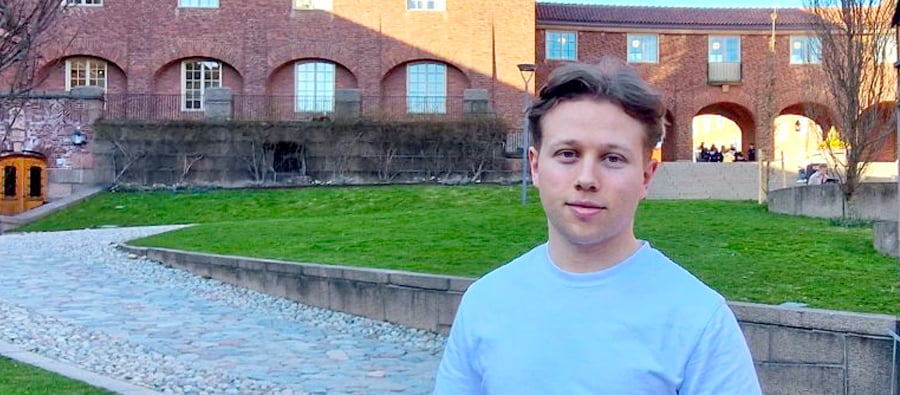Leachate treatment methods evaluated in a new project at KTH
Oliver Colett, a chemical engineering student at KTH Royal Institute of Technology in Stockholm, has evaluated methods for landfill leachate treatment in his degree project at PreZero Recycling. The project was carried out in collaboration with Chromafora, which was operating a pilot leachate treatment plant at Kovik on behalf of PreZero.
How come you chose to do your degree project on leachate treatment?
During my studies at KTH, I carried out several projects involving water treatment. It’s become something of a niche for me and I find the subject very interesting. So when a relative who works at PreZero told me that one of their landfills would perform a pilot plant project for removing PFAS from their landfill leachate during the exact same period I was planning to carry out my degree project, the timing could not have been better. It was fantastic to have the opportunity to do my degree project on this subject.
Can you describe how you performed the work?
I started by collecting and compiling historical data from previous PFAS analyses carried out at the Kovik leachate treatment plant, not only on the leachate but also at other test points around their recycling facility to gain an overview of the situation. Then I made a theoretical compilation of previous PFAS separation methods tested in Sweden such as activated carbon, ion exchangers, foam fractionation and various membranes. Then I compared these methods with the results from the analysis at Chromafora’s plant, which were collected during the time I was on site.
What was your objective?
My objective was to investigate, document and evaluate treatment outcomes from Chromafora’s plant. But it also included a comparison study between activated carbon, ion exchangers, membranes and foam fractionation previously tested based on literature studies of lab tests, pilot tests and a full-scale plant.
What new insights did your work bring you?
During the course of my work, I realized that no matter how optimized a method is, it must be modified in one way or another as each situation is unique and requires a bespoke solution, especially when detoxifying water with complex compositions.
What was your most interesting discovery? Were there any surprises?
For me, the most fascinating discovery was that despite all the existing technologies tested on both long and short-chain PFAS, Chromafora’s method was really outstanding in that it outperformed the earlier methods. I was very impressed by this when I received the first analysis report.
Given the global PFAS situation, how important is it to remove PFAS from leachate already discharged?
Given that the EU has prohibited PFOA since 2020 and the use of PFOS has been prohibited since 2008 through the Stockholm Convention, and that several other PFAS are under increased scrutiny and regulation, I believe removing PFAS from leachate will become even more important in the future. This is because earlier knowledge about the health risks was not as extensive, but these risks are now becoming increasingly apparent to the public.
What other leachate treatment methods did you compare in your analysis? What was the conclusion?
I looked at technologies tested in labs, pilot tests and full-scale facilities with a focus on Swedish water to be sure of a composition as similar as possible between the various methods. The methods I investigated were ion exchangers, foam fractionation, activated carbon (GAC and PAC) and membrane filtration (NF and RO). When comparing these methods, I noted that the reduction rate varied depending on whether it concerned short or long PFAS chains.
And your thoughts on Chromafora’s method?
Chromafora’s method looks very promising and was clearly the best of the methods I investigated, as it showed high reduction rates for both short and long-chain PFAS. However, this assertion is based on my not having performed a cost analysis and only using data collected from the pilot plant for a short period.
What recommendations did you give PreZero at the end of the analysis?
The pilot plant showed Chromafora’s method for detoxifying water from long and short-chain PFAS to be utterly feasible. I recommend evaluating the method on a larger scale to gain a deeper understanding of how well it performs at higher flow rates and with larger volumes.
Is there anything else you would like to add about your degree project and the outcomes?
I feel extremely privileged to have enjoyed the opportunity to work on a project that appeals to my interests and which has given me a deeper understanding of how a real facility is put together.
Thumbnail sketch of Oliver Colett
Age: 26
Home: Lidingö, Stockholm, Sweden
Education: Chemical engineer
Best thing about studying at KTH: Student life and quality of education
Leisure interests: Golf, mountain biking, skiing and cooking
Hidden talent: Surfing
Next step after graduation: After graduating, I plan to explore different career opportunities in my field of study to see what’s right for me





